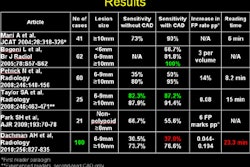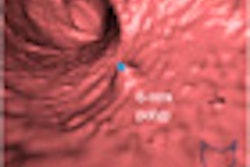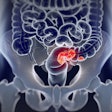Computer-aided detection (CAD) works best in virtual colonoscopy when human readers do their job first, according to a new study from London. The use of CAD as a second reader improved both per-patient and per-polyp detection in the study involving multiple experienced readers, while running CAD concurrently with the initial read was less effective.
Although CAD is thought to help inexperienced readers in virtual colonoscopy (also known as CT colonography or CTC), the technology's performance in previous studies has been underwhelming. Research also suggests that the reading paradigm is an important determinant of accuracy; however, larger studies are needed to prove the association, wrote Steve Halligan, MD, and colleagues from University College London (Radiology, November 17, 2010).
"By performing a multireader study in a representative environment with experienced radiologists, we sought to quantify the changes in reader performance levels, if any, during the interpretation of CT colonographic data when a CAD system was implemented as a second reader or concurrent reader," they wrote.
The study looked at polyp detection in 112 patients from 12 hospitals who had undergone prone and supine virtual colonoscopy. Patients subsequently underwent optical colonoscopy, which served as a reference standard. Fifty-six of the patients had a total of 132 polyps at CTC.
Then, 16 experienced radiologists from 12 hospitals interpreted each case three times on separate occasions: first without CAD, then with second-read CAD (ColonCAD API 3.1, Medicsight, London) after the initial unassisted read, and third using a concurrent reading paradigm.
Both the reading paradigm and the order of interpretation were randomized, with a minimum of a month's time separating interpretations of the datasets. The readers had experience performing from 50 to 1,000 virtual colonoscopy cases (mean, 64) before beginning the study. Two different workstations were used for interpretation: 13 of the readers used the Viatronix V3D platform (Viatronix, Stony Brook, NY) and three used the Vitrea2 4.0 Colon platform (Vital Images, Minnetonka, MN).
Used as a standalone system without input from radiologists, CAD correctly identified polyps in 40 (71%) of the 56 patients with true-positive findings. When polyps were classified according to size, the system detected 69 (52.3%) of the total 132 polyps of all sizes, 40 (71%) of the 56 polyps 6 mm or larger, and 14 (93%) of the 15 polyps 10 mm or larger. False-positive prompts averaged 13.6 per patient on prone and supine studies combined.
Per-patient sensitivity for detecting polyps of any size rose significantly with the use of second-read CAD (mean increase, 7.0%; 95% confidence interval [CI]: 4.0%-9.8%) and concurrent CAD (mean increase, 4.5%; 95% CI: 0.8%-8.2%), the authors noted. At the same time, mean per-patient specificity varied little with the use of second-read CAD (mean decrease, -2.5%) or concurrent CAD (mean decrease, -2.2%).
The use of CAD as a second reader also increased per-polyp sensitivity for polyps 6 mm or larger (mean increase, 9.0%; 98.3% CI: 4.9%-12.8%), as well as for lesions 5 mm or smaller (mean increase, 5.9%; 98.3% CI: 3.2%-9.1%).
When looking only at polyps 6 mm or larger, CAD's benefit in sensitivity remained significant (mean increase, 7.1%), but the 4.2% increase logged in the concurrent use of CAD was insignificant.
"Use of second-read CAD significantly improved per-patient detection without a clinically unacceptable decrease in specificity, whereas use of concurrent CAD was less effective," they concluded. "Use of concurrent CAD increased per-polyp detection significantly, but the increase was mainly due to the enhanced detection of polyps 5 mm or smaller, whereas use of second-read CAD significantly improved the detection of polyps 6 mm or larger."
Few previous studies have compared concurrent and second-read paradigms. A small study by Taylor and colleagues also found better odds of polyp detection using second-read CAD, but the benefit was measured against the results of the unassisted portion of a double read rather than in a separate, unassisted reading, they wrote.
Other advantages over previous studies included a larger database and more natural workflow setup. "Our readers were representative of target users, performing 5,376 interpretations in environments and over time scales that are generalizable to daily practice," the authors wrote.
Among the limitations, the study used two separate workstations and various scanners and bowel preparation techniques. Also, the prevalence of colonic abnormality in the study was 50% to maximize its power; however, previous CAD studies in mammography have suggested better performance in low-prevalence environments.
Finally, it's important to note that CAD's benefits are variable, and for some readers they will be nonexistent.
"The reason for this is obscure, and further research aimed at predicting the effect of CAD assistance on individuals is required," they wrote.
By Eric Barnes
AuntMinnie.com staff writer
December 14, 2010
Related Reading
Clinical study backs newly cleared VC CAD software, August 10, 2010
Minimal-prep VC gets new boost from dual-energy CT, July 21, 2010
VC CAD application does well alone and as reader aid, February 15, 2010
New VC CAD algorithm reveals submucosal colon cancers, February 4, 2010
VC screening effective in Medicare-age screening cohort, January 27, 2010
Copyright © 2010 AuntMinnie.com




















